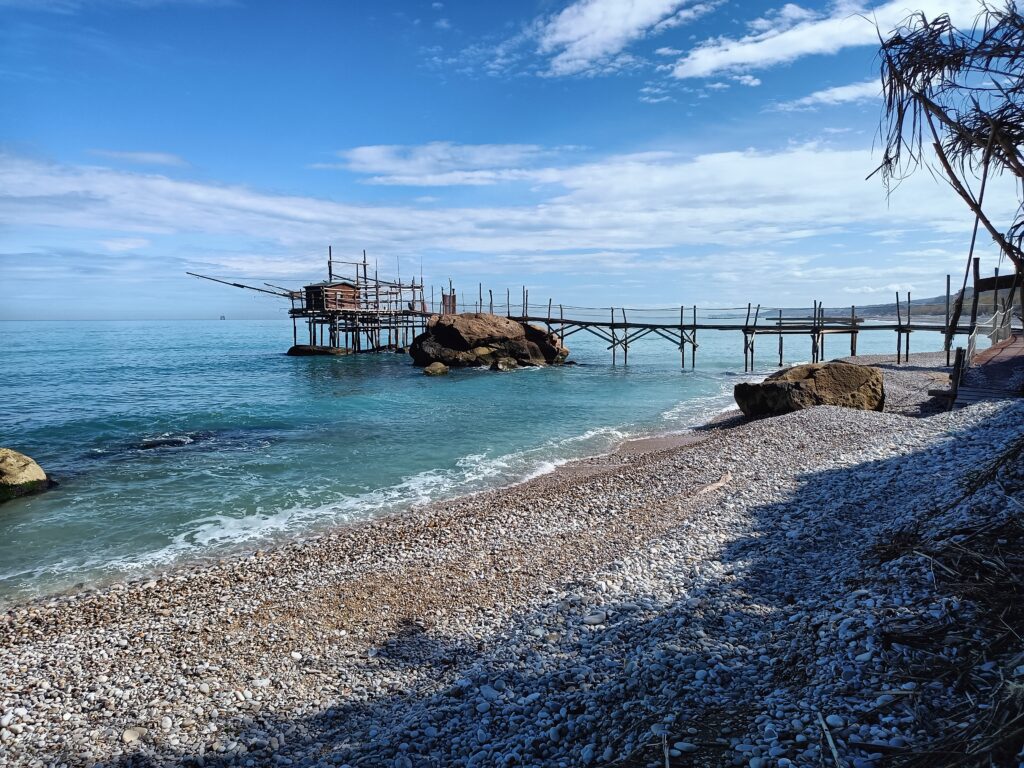
The Trabocchi are a fascinating and ancient tradition found along the Adriatic coast of Italy, particularly in the regions of Abruzzo and Molise. These wooden fishing structures, suspended over the sea on stilts, have been an integral part of the coastal landscape for centuries. They represent not only a unique method of fishing but also an important symbol of the region’s cultural and historical heritage.
The origin of the trabocchi dates back to the 16th century, although some believe their roots may stretch even further into antiquity. The structures were originally built by local fishermen as a way to catch fish in a manner that was efficient and sustainable. A trabocco consists of a large wooden platform perched over the water, supported by tall stilts. At the end of the platform is a long horizontal beam, or “braccio,” to which large nets are attached.
The fishing technique used on trabocchi involves casting a large net into the sea, which is then pulled back onto the platform using ropes and pulleys. The fishermen must carefully time their movements to match the rhythm of the tides and the behavior of the fish. This requires deep knowledge of the sea and exceptional skill, as the operation is physically demanding and requires precision.
In the 20th century, many trabocchi fell into disrepair due to the decline of traditional fishing methods and the rise of industrial fishing. However, in recent years, some of these historic structures have been restored and transformed into restaurants or tourist attractions, where visitors can enjoy freshly caught seafood while appreciating the stunning coastal views.
The trabocchi have become more than just fishing tools; they are now a symbol of the cultural identity of the region. The method of fishing on the trabocchi embodies a way of life that is deeply connected to nature and the rhythms of the sea. They serve as a reminder of the resilience and ingenuity of local communities who relied on the sea for their livelihood.
One of the best ways to experience the trabocchi today is by walking the “Sentiero dei Trabocchi” (Trabocchi Trail), a scenic path that runs along the coast from Ortona to Vasto. This trail allows visitors to explore the region’s natural beauty while discovering the trabocchi in their original settings. The sight of these majestic wooden structures against the backdrop of the Adriatic Sea offers a glimpse into a time when life on the coast was ruled by the tides and the seasons.
The trabocchi are not just fascinating relics of the past; they are living symbols of the enduring relationship between humans and the sea. They stand as a testament to the resourcefulness and cultural depth of the people of Abruzzo and Molise. Whether you are interested in history, nature, or simply enjoying fresh seafood, visiting the trabocchi is an experience that will leave you with a deeper appreciation for the rich heritage of Italy’s Adriatic coast.
I trabocchi sono una tradizione affascinante e antica che si trova lungo la costa adriatica dell’Italia, in particolare nelle regioni dell’Abruzzo e del Molise. Queste strutture di legno, sospese sul mare su palafitte, sono state una parte integrante del paesaggio costiero per secoli. Rappresentano non solo un metodo di pesca unico, ma anche un simbolo importante del patrimonio culturale e storico della regione.
L’origine dei trabocchi risale al XVI secolo, anche se alcuni ritengono che le loro radici possano essere ancora più antiche. Le strutture furono originariamente costruite dai pescatori locali come un modo per pescare in modo efficiente e sostenibile. Un trabocco è composto da una grande piattaforma di legno sospesa sull’acqua, sostenuta da alte palafitte. Alla fine della piattaforma si trova un lungo braccio orizzontale, detto “braccio,” al quale sono attaccate grandi reti.
La tecnica di pesca utilizzata sui trabocchi prevede il lancio di una grande rete in mare, che viene poi ritirata sulla piattaforma utilizzando corde e pulegge. I pescatori devono sincronizzare attentamente i loro movimenti con il ritmo delle maree e il comportamento dei pesci. Ciò richiede una conoscenza approfondita del mare e abilità eccezionali, poiché l’operazione è fisicamente impegnativa e richiede precisione.
Nel XX secolo, molti trabocchi caddero in rovina a causa del declino delle tecniche di pesca tradizionali e dell’ascesa della pesca industriale. Tuttavia, negli ultimi anni, alcune di queste storiche strutture sono state restaurate e trasformate in ristoranti o attrazioni turistiche, dove i visitatori possono gustare pesce fresco mentre ammirano le splendide vedute costiere.
I trabocchi sono diventati più di semplici strumenti da pesca; sono ora un simbolo dell’identità culturale della regione. Il metodo di pesca sui trabocchi incarna un modo di vivere profondamente legato alla natura e ai ritmi del mare. Essi fungono da promemoria della resilienza e dell’ingegnosità delle comunità locali che dipendevano dal mare per il loro sostentamento.
Uno dei modi migliori per vivere i trabocchi oggi è percorrere il “Sentiero dei Trabocchi,” un percorso panoramico che si estende lungo la costa da Ortona a Vasto. Questo sentiero consente ai visitatori di esplorare la bellezza naturale della regione, scoprendo i trabocchi nei loro ambienti originali. La vista di queste maestose strutture di legno contro lo sfondo del Mare Adriatico offre uno spunto su un’epoca in cui la vita sulla costa era governata dalle maree e dalle stagioni.
I trabocchi non sono solo affascinanti reperti del passato; sono simboli viventi del duraturo rapporto tra l’uomo e il mare. Sono una testimonianza della risorsa e della profondità culturale delle persone dell’Abruzzo e del Molise. Che tu sia interessato alla storia, alla natura o semplicemente a gustare pesce fresco, visitare i trabocchi è un’esperienza che ti lascerà con una maggiore apprezzamento per il ricco patrimonio della costa adriatica d’Italia.